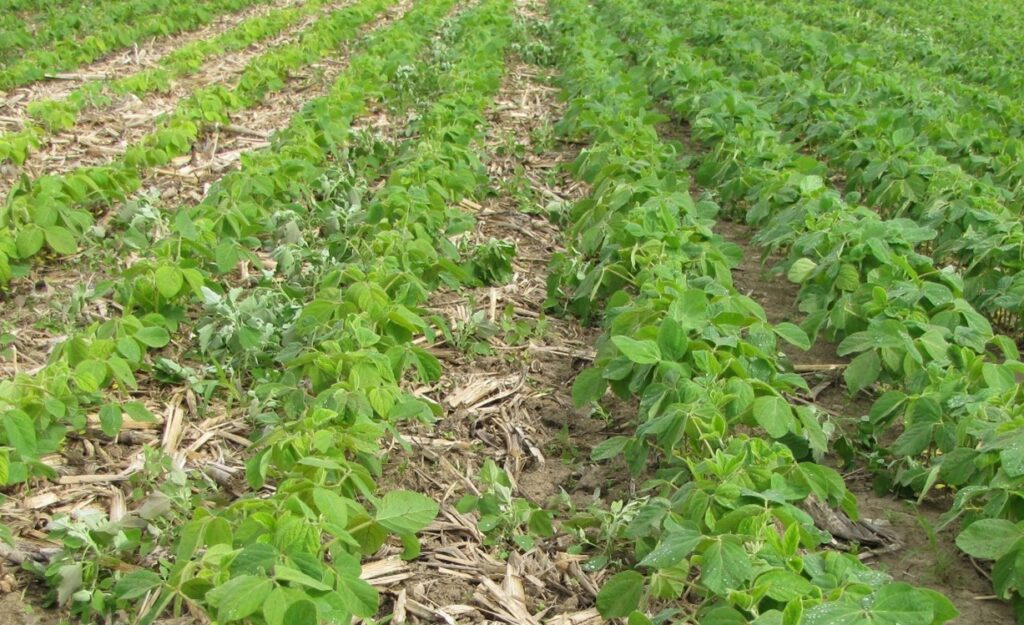Cereal Residue
When soybeans follow a cereal crop, pay special attention to the management of cereal residue, beginning at harvest to avoid problems with soybean establishment. In research trials conducted at the University of Guelph, removal of the wheat straw improved seedbed conditions, stand establishment, growth, and yield of no-till soybeans. Results are shown in Table 1, Effect of Tillage and Wheat Residue on Soybean Yield. If straw is left in the field, it must be spread evenly to minimize issues for the following soybean crop. Large amounts of cereal residue will form a mat which slows soil warming and drying in the spring. The mat of residue will delay soybean planting, reduce emergence, slow early growth, and increase slug feeding.
Table 1. Effect of Tillage and Wheat Residue on Soybean Yield
| Stubble heights were approximately 20-30 cm (10-12 in.) except for plots where stubble was cut and removed. Soil types – Centralia: loam, clay loam, Wyoming: silty clay, silty clay-loam. Soybeans were seeded with a JD 700 conservation planter equipped with a single 3.2 cm (1.25 in.) coulter. The no-till planter was equipped with tine row cleaners. | |
| Tillage (and Straw Management) | Soybean Yield |
| Fall moldboard/straw baled | 3.29 t/ha (48.9 bu/acre) |
| Fall chisel/straw baled | 3.30 t/ha (49.1 bu/acre) |
| Fall disk/straw baled | 3.21 t/ha (47.8 bu/acre) |
| Fall zone-till/straw baled | 3.19 t/ha (47.5 bu/acre) |
| No-till/all straw and stubble remain | 2.27 t/ha (33.8 bu/acre) |
| No-till/straw baled but stubble remains | 3.00 t/ha (44.7 bu/acre) |
| No-till/straw baled, and stubble removed | 3.28 t/ha (48.8 bu/acre) |
Corn Residue
Soybeans often follow corn in a crop rotation. As corn yields have increased and corn stalk health has improved the amount of corn residue that soybean growers must manage has increased. Poor plant stands, slow growth, and slug feeding, can occur with large amounts of corn residue, see figure 1.

Figure 1. Left side shows yellow plants struggling with excess corn residue. Right side has little corn residue.
Research has shown that in heavy corn residue, a row unit planter with row cleaners or coulters will perform better than a no-till drill. Using vertical tillage will reduce the amount of corn residue that a drill must penetrate, improving the performance of a drill. Minimum tillage in the fall or spring without the need for secondary tillage improves seedbed conditions by creating looser and finer soil. These soil conditions will improve plant stands and early soybean growth while maintaining adequate residue on the surface reducing soil erosion.
Corn residue tillage trials have been conducted in Ontario to investigate the impact of corn residues in seven tillage strategies (no-till, no till and stalk chop, vertical tillage twice in the fall, fall and spring vertical tillage, fall disc plus spring cultivate, fall disc plus fall cultivate, and fall plowed plus spring cultivate), three corn residue removal treatments (none, intermediate, and nearly complete), and two planters (row-unit and drill). Table 2, Effect of Tillage and Corn Residue on Soybean Yield, shows the impact of residue removal.Overall, soybean yields were not different between no-till and plowed treatments, despite delayed development, and cooler/wetter seedbeds where corn residue was not removed. Shallow tillage after corn harvest did not increase yields compared to no-till in this study. Removal of corn residue did not increase soybean yields when averaged across tillage systems. However, no-till yield was lowered by 0.36 t/ha (5.3 bu/ac) when corn stalks were chopped in the fall and left undisturbed on the surface, but only in the drill-planted treatments. Soybean planted with a row-unit planter yielded 0.13 t/ha (1.9 bu/ac) higher compared to a drill when averaged across treatments. This finding suggests that corn residue within the soybean row needs to be managed but corn residue between rows has less impact. In this study, shallow tillage and/or physically removing corn residue did not improve soybean yield compared to no-till alone.
Table 2. Effect of Tillage and Corn Residue on Soybean Yield
| Corn residue/tillage treatment | Corn Residue Removal | ||
| None | Intermediate | Nearly Complete | |
| No-till | 3.31 t/ha (49.2 bu/ac) | 3.26 t/ha (48.5 bu/ac) | 3.45 t/ha (51.3 bu/ac) |
| No-till and stalk chop | 3.09 b* t/ha (45.9 bu/ac) | 3.16 b t/ha (47.0 bu/ac) | 3.43 a t/ha (51 bu/ac) |
| Fall vertical till (2x) | 3.31 t/ha (49.2 bu/ac) | 3.17 t/ha (47.1 bu/ac) | 3.30 t/ha (49.1 bu/ac) |
| Fall vertical till + spring vertical till | 3.21 t/ha (47.7 bu/ac) | 3.20 t/ha (47.6 bu/ac) | 3.15 t/ha (46.8 bu/ac) |
| Fall disc + spring cultivate | 3.17 t/ha (47.1 bu/ac) | 3.15 t/ha (46.8 bu/ac) | 3.24 t/ha (48.2 bu/ac) |
| Fall disc + fall cultivate | 3.36 a t/ha (50.0 bu/ac) | 3.13 b t/ha (46.5 bu/ac) | 3.41 a t/ha (50.7 bu/ac) |
| Fall plow + spring cultivate | 3.37 t/ha (50.1 bu/ac) | 3.32 t/ha (49.4 bu/ac) | 3.39 t/ha (50.4 bu/ac) |
| * Means within tillage and across corn residue removal treatments followed by the same letter are not different according to the Fisher’s Protected LSD Test (P = 0.05). | |||
References
Vanhie, M., Deen, W., Bohner, H., & Hooker, D. C. (2015). Corn residue management strategies to improve soybean yield in northern climates. Agronomy Journal, 107(5), 1940–1946. https://doi.org/10.2134/agronj15.0190